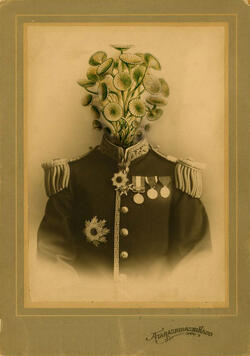Table of Contents
Patabotany
Patabotany “symbolically attributes the properties of plants, described by their virtuality, to their lineaments” (adapted from Alfred Jarry's Pataphysics)
Patabotany is a hybrid between ethnobotany (the study of cultural, spiritual and medical uses of plants) and pataphysics, the science of imaginary solutions (Jarry, 2001). Patabotany poses the question: what if the metaphors, cultural rituals and myths associated with plants could be discovered in their physical properties – in their shapes, colours and functions? What if mushrooms were in fact aliens attempting to communicate with humans, what organs could mushrooms and human grow, to improve reciprocal communication? If red roses were able not just to symbolise love, but write love letters through chemotropism, guided by lovers’ pheromones? Patabotany is a cross-pollination between myth and reality: it is an interpretation of interpretation, an abstraction of abstraction, emerging at the edges of poetry, magic and biology. Patabotany subverts the contemporary drive to instrumentalise culture and nature in economic or utilitarian constructs. It describes a world where the believable is grafted onto the improbable, where logic is pollinated with a hybrid of sensuality and paradox, where botany and permaculture mutate into an epic of nurturing and seduction in relentless cycles of living and dying. From groworld_vegetal_culture
Related:
- Parallel Botany by Leo Lionni
- fictional plants:
Pataecology
Pataecology proposes…
an ecological, biomimietic systems thinking, an ecology “superinduced upon metaphysics […] extending as far beyond metaphysics as the latter extends beyond physics.” (Jarry, 1996) An ecology of imaginary solutions, inhabited by the plausible and improbable, as they pollinate or mutate, eating or being eaten. in –> groworld_hpi_ii
Patabotanical Morphology
For ordinary plant morphology to be patafied see phytomorphology
Other morphological principles:
- allotropy: the appearance of a mineral in several forms, like carbon (grafite,diamond,buckeyballs)
- aplasia: full or partial standstill in growth of tissue or organs.
- stratification (from Dutch) = layered order of stone, sediment, body-tissue etc.
Miscellaneous:
- dysteleology (Haeckel; 1834-1919) = study of purposelessness in nature (leer van de doelloosheid in de natuur.)
- echokynesis: pathological compulsion to mimic movements.
- epizoic: living on the body of an animal.
- ideoplasia(from Dutch): changing or deforming of organic tissue due to mental influence.
- taumatology: study of miracles.
- Dance of Saint Vitus (from Dutch) = neurological disease that brings with it all kinds of sudden and involuntary movements of the limbs, face and muscles.
- Formication : a somewhat unusual, but medically well-known, abnormal sensation. This sensation closely resembles the feeling of insects crawling on and/or under the skin, and can also include sensations which resemble those of insects stinging or biting.
- spontaneous generation: frogs are born from mudd, mice from rotting wheat, etc.

